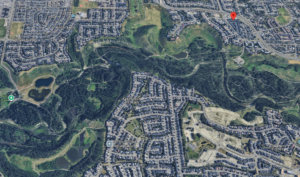Canyon Meadows – Calgary, AB
October 13, 2025 By: Jeff van der Ploeg
Location: Canyon Meadows - Calgary, Alberta

Introduction
When my wife and I moved from Edmonton to Calgary last year, our goal was to find a home in the southside, close to walking trails and the city’s largest green space. At first glance, the Canyon Meadows neighbourhood in southwest Calgary might seem like a typical suburb, but it holds a much deeper ecological story. This essay explores that story by sharing the history of Fish Creek Provincial Park (Fish Creek) and the surrounding community. From Indigenous stewardship to modern conservation, the area illustrates the evolving relationship between people and the natural world.
Indigenous Land Use Before Colonization
For thousands of years before Calgary became a city, the land now known as Fish Creek was part of a thriving ecosystem managed by Indigenous peoples. Archaeological evidence indicates that humans have inhabited this region for over 8,000 years, with bison pounds dating back to around 2500 BCE (Alberta Parks, n.d.). The Blackfoot Confederacy, which includes the Kainai, Piikani, and Siksika Nations, along with the Tsuu T’ina and Stoney Nakoda peoples, used the valley for seasonal hunting and gathering. They depended on its diverse wildlife and clean water sources to support their communities.
These nations practised methods that valued respect for the land. They used controlled burns to sustain grasslands and migrated with the seasons, allowing ecosystems to recover. This careful balance shifted after European settlers arrived and began reshaping the area for agriculture and industry.
Early Settlement and Ranching
European settlers arrived in the late 1800s. Early farmers like John Glenn and Sam Livingston grew grain in the valley, with Glenn establishing Alberta’s first irrigation project in 1879 (Calgary River Valleys, 2022). By 1896, the Bow Valley Ranch had been established and was later bought by cattleman Patrick Burns in 1902.
This shift from Indigenous stewardship to commercial ranching greatly impacted the environment. Native grasslands were converted into pastureland, and cattle grazing altered the soil and water systems. While these changes supported Calgary’s expansion, they also caused ecological shifts that persist today (CREB, 2019).
Fish Creek Provincial Park: A Protected Ecosystem
In response to concerns about urban sprawl and habitat loss, Fish Creek was designated an official provincial park in 1975 (Alberta Parks, n.d.). Today, it ranks among North America’s largest urban parks, encompassing more than 1,300 hectares of forests, wetlands, grasslands, and riparian zones. The park is inhabited by moose, bobcats, cougars, and over 200 bird species (CREB, 2021).
Historically, Fish Creek’s waters supported native trout, including Bull Trout and Cutthroat Trout. However, urban development and the introduction of non-native fish led to declines in these populations. Local groups like Friends of Fish Creek Provincial Park now work to restore habitats, remove invasive species, and educate visitors (Calgary River Valleys, 2022). Beyond recreation, the park plays a vital role in stormwater management and climate resilience by absorbing runoff, reducing flood risk, and cooling the surrounding area.
Canyon Meadows Community Stewardship
The Canyon Meadows area was annexed by Calgary in 1961, and development started in 1963 (CREB, 2021). The neighbourhood’s curved streets, cul-de-sacs, and easy access to green space reflect an intention to stay connected with nature. Even today, deer, bobcats, and other wildlife are frequent visitors to our yards.
The Canyon Meadows Community Association (CMCA) builds on this connection through sustainability initiatives, including:
- Community Clean-Up Days, which help residents safely dispose of electronics, batteries, and other waste (CMCA, n.d.).
- Earthware Drop-Off, a program encouraging the return and reuse of takeout containers (CMCA, 2022).
- Public Art Projects, such as vinyl-wrapped garbage bins and fence murals that blend beautification with environmental messaging (CMCA, n.d.).
The CMCA also acknowledges the area’s Indigenous history in its newsletters, supporting reconciliation and inclusive stewardship.
Environmental Challenges and Invasive Species
Despite these positive efforts, the park and neighbourhood continue to face challenges. Invasive species, such as non-native trout and ornamental plants, threaten native biodiversity by outcompeting local species. Climate change adds further pressure, with rising temperatures and changing precipitation patterns affecting water quality and wildlife habitat (Calgary River Valleys, 2022).
Stewardship programs aim to address these issues by restoring native vegetation, enhancing water systems, and encouraging sustainable practices. These efforts show that even a suburban community can contribute significantly to environmental protection.
Conclusion
The ecological history of Candle Terrace and the surrounding area is a story of change and resilience. From Indigenous stewardship through the ranching era to modern conservation, both Fish Creek Provincial Park and the Canyon Meadows Community Association have played a role in maintaining the natural character of this region for future generations.
References
Alberta Parks. (n.d.). History – Fish Creek Provincial Park. https://www.albertaparks.ca/parks/kananaskis/fish-creek-pp/information-facilities/history/
Calgary River Valleys. (2022). Fish Creek history. https://calgaryrivervalleys.org/wp-content/uploads/2022/01/Fish-Creek-History.pdf
Canyon Meadows Community Association. (n.d.). Inspiring community. https://cmca.ca
Canyon Meadows Community Association. (2022, April 29). Canyon Meadows news from the office for May. https://mycalgary.com/community/calgary/sw-communities/canyon-meadows/canyon-meadows-news-from-the-office-for-may/
CREB®. (2021, March 5). Colourful community: Natural and man-made beauty collide in Canyon Meadows. https://www.creb.com/News/CREBNow/2021/March/colourful_community_canyon_meadows/
CREB. (2019, January 3). The history of Fish Creek Provincial Park. https://www.creb.com/News/CREBNow/2019/January/nature_or_nuture/